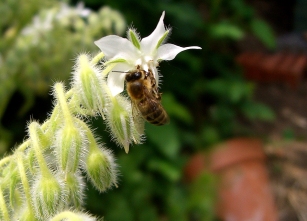COMMON EDIBLE FLOWERS

Borage flower with a bee.
Borage – leaves & flowers are edible. Tiny five-petalled flowers taste sweet and are a delight used as a garnish for salads and desserts.
Calendula – edible marigold. Flower petals make a colour addition or garnish to salads.
Chive flowers – purple pom-poms.
Coriander flowers: Coriander goes into flower with delicate umbrels bearing tiny white flowers. Good used in salads. (The seeds are also edible, as are of course the leaves.)
Cornflower – A sweet-to-spicy clove-like flavour.
Dahlia – Flavours range from water chestnut and spicy apple to carrot.
Hibiscus – Great addition to fruit salads or to make a citrus-flavoured tea. Hibiscus flowers can be infused to make a mildly citrus flavoured tea. The petals can be cut and added to fruit salads.
Honesty – Aka ‘moonwort’ or ‘moneywort.’ Belongs to the mustard family. Honesty leaves and flowers both have a cabbage-like taste. The seeds taste like mustard. Leaves can be collected and used as a green vegetable or in salads before the flowers appear. Honesty flowers can be added to salads. The seeds can be used to make a mustard substitute which is strengthened by crushing and mixing with cold water.

Honesty in flower in Woods. 13 April 2020.
Honeysuckle – Enjoy the nectar fresh, or use petals make syrup, pudding, or a tea.
Lilac – Enjoy mixed with cream cheese or yogurt as a dip or spread.
Magnolia – The young flowers can be pickled or used fresh in salads.
Nasturtium – Tasting peppery, like watercress, these make a lovely salad addition. While working on our plot sometimes we make a wrap of a flower inside a nasturtium leaf, which makes a quick peppery treat.

Nasturtium flower (8 May 2020)
Pansy – Mild and fresh-tasting, they’re great in a green salad or as a garnish.
Rose petals – Lovely in drinks, fruit dishes, jams and jellies thanks to its delicate
fragrance. Especially true of damask rose.
Scented Geraniums– The flavours range from citrussy to a hint of nutmeg.
Cape Jasmine – Extremely fragrant, they’re ideal for pickling, preserving, and baking.
Garlic Chive flowers – white star-shaped blossoms
Wood violet

Wood violet in flower. (Sat 23 March 2019 on the allotment). Photo by G.
10 Unusual Edible Flowers
- Forget-me-not– Delicious as a trail snack on its own or as a garnish. Flowers can be sprinkled over desserts to add a delicate scented flavour
- Sunflower– The mild nutty taste makes the petals good in salads or stir fries.
- Hollyhock – Remove the centre stamen (with pollen) before eating. Petals can be crystallised or use them to make a delicately flavoured syrup to use with puddings.
- Camellia – Used fresh as garnishes or dried and then used in Asian cuisine.
- Fuchsia – Enhance the flavour by removing all green and brown bits and the stamen.
- Freesia – Great infused in a tisane with lemon juice and zest.
- Gladiolus – Mild in taste (similar to lettuce), they’re good in sweet or savoury dishes. The lettuce flavoured flowers can be used with sweet or savoury spreads; individual petals can be included in salads.
- Peony – The petals taste lovely fresh in salads, or lightly cooked and sweetened. Peony petals can be added to salads, or cooked slightly and sweetened for a treat. Peony water was once considered a delicacy and blooms can be floated in punches
- Alpine pinks (aka Dianthus) – Tasting of clove, they’re good in flavoured sugars, oils and vinegars. Use the clove-like tasting petals for adding to cakes, either for flavour or decorating. Also suitable to garnish soups, salads and sauces.
Poisonous flowers you should NEVER eat
- Daffodil – Eating any part of a daffodil will cause distress due to the toxin, lycorine.
- Foxglove – Contains naturally-occurring poisons (digitalis) that affect the heart.
- Oleander – The whole plant is highly-toxic – one of the most toxic garden plants.
- Clematis – Mild but toxic: contact with clematis (mouth or skin) can cause irritation.
- Bluebell – All parts of the bluebell contains toxic glycosides.
- Rhododendron – Its toxins can impact heart rhythm and blood pressure.
- Larkspur – Its toxic alkaloids are fast-acting and potentially life-threatening.
- Hydrangea – The small amount of cyanide in Hydrangeas make them dangerous.
- Lily-of-the-Valley – Pretty, but they contain convallatoxin, which should not be ingested.
From https://www.thompson-morgan.com/edible-flowers

